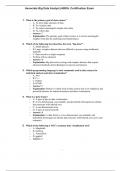Exam (elaborations)
Associate Big Data Analyst (ABDA) Practice Exam
- Course
- Institution
This practice exam is designed for candidates aiming to become certified Associate Big Data Analysts (ABDA). The exam covers big data concepts, including data collection, storage, analysis, and visualization techniques. Topics include Hadoop, Spark, data mining, and machine learning algorithms. Can...
[Show more]



